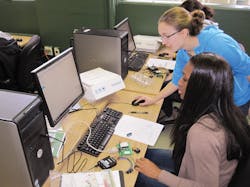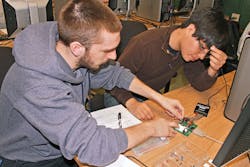There’s growing momentum and interest in increasing the number of students focused on science, technology, engineering, and mathematics (STEM) courses. But reality can be an impediment to succeeding in this goal, as many organizations and institutions are finding out.
At the University of Massachusetts (Lowell), surveys of incoming engineering students in the Electronics and Computer Engineering (ECE) program showed that less than a quarter of them have had any experience with hands-on engineering-related projects, including building a basic circuit, using a voltmeter, or handling a soldering iron. The gap was widest, as expected, for female first-year students as well as those from urban areas.
Related Articles
- Is There Really A Shortage Of Engineers?
- What Should Colleges Be Teaching EEs?
- Interview: Jane Prey Targets The Gender Gap In Computing And Engineering
It’s not limited to those groups, however. Even smaller high schools in more affluent areas fall short on practical labs, due to space, cost, and even presumed liability issues. The college-level situation was not much better, since a conventionally equipped electronics lab is costly, requires significant space, and can usually only be used during school hours or sessions, not off hours or during schedule breaks and holidays.
Theory Versus Practice
Due to the lack of lab access, classes on basic engineering theory were just that: theory. They didn’t resonate with the students. They seemed dull, disconnected, and disjointed from what engineering could and should be. They also contributed to a low retention rate for incoming ECE students. The enthusiasm they had for engineering dissipated, while the investment they and the school made in the courses and curriculum was lost.
We set out to change this situation by getting ECE students meaningful hands-on project exposure in their first year and making it an engaging, valuable, flexible, and low-cost experience. But the conventional way of doing this, with a bench of test equipment and breadboards, was not the answer.
Instead, we opted for a different approach with what we called a “lab in a box,” a complete electronics workbench that’s also portable, flexible, and low-cost (Fig. 1). With this lab, every student gets his or her own setup and tackles individual projects.
This is not a “virtual” lab, with PC-based simulations of circuits and presumed results. This is a real, hands-on circuitry lab where students build basic circuits, exercise them with waveforms and switch closures, collect analog and digital data, control outputs, and analyze the results. In addition to processing the data with their algorithms, they can display it on the two-channel oscilloscope—a pretty good achievement for students who previously hadn’t even grasped the concept of a scope.
What The Lab Provides
It is one thing to say that a lab in a box is a good idea. But it’s another thing to actually have one. We wanted a complete lab that could be used anywhere and only needed a PC with a USB connection. Fortunately, a commercially available solution was available (Fig. 2).
It consists of:
• A parts kit (resistors, capacitors, LEDs, and other basic components)
• The Parallax “Board of Education” microcontroller with prototyping board
• An Analog Discovery Kit, which is a complete test system including a two-channel oscilloscope, a voltmeter, a function generator, a digital logic analyzer, and a power supply, among other features
• Software to tie it all together
The students begin by learning basics such as driving an LED and using the voltmeter to measure the drop across the LEDs. As a next step, they write a simple program to blink the LED, then one to alternately blink two LEDs, and use the scope to see the corresponding waveforms. For most of these students, this sort of coding and programming is a new and vital experience, despite their daily Web and online interaction.
As the course and projects continue, the students expand their interaction by reading the status of switches, controlling a small motor, exploring RC time constants, looking at the spectra of audio signals, writing code to generate a ring tone, and using transistors and op amps. There is also an open-ended design aspect, where the students get a design challenge and have to figure out a solution—this is in contrast to the cookbook “just do it this way” approach.
To minimize high-frequency issues, most of the projects are in the lower frequencies through the audio band, but that is more than enough for meaningful projects. The students make extensive use of the scope, the function generator, and, of course, the power supply.
Conclusion
By the time the students go into their sophomore year, all of them have used test equipment. They also have completed real, hands-on projects; written applications code; sensed/controlled real-world analog and digital signals; and analyzed and observed the results in various ways (Fig. 3). The total cost, per student, is comparable to the cost of a textbook, but with far greater impact.
We found other advantages to this “lab in a box” approach. In other engineering labs, whether for previous generations or with today’s students, a team would be assigned to a bench. Often, though, only one student would do most of the work while the others watched (or maybe didn’t even do that). In contrast, this approach gives every student the opportunity and obligation to do the projects, although they can certainly share ideas and assist each other when troubleshooting.
The portability and convenience of the kits also means students can use them on their own terms, at their dorms, library, other study areas, or home; at their preferred time of day (or night); and during school breaks. If the student is “stuck” or needs to repeat some steps, there’s no public embarrassment. It also changes (or “flips”) the relationship with the teaching assistant (TA), as students can now bring their work in to show to the TA and get help if they need it, rather than using their lab hours mostly waiting their turn for assistance.
This type of lab is much more compatible with today’s cost and space limits, of course. Equally important, though, it fits the 21st-century needs of ECE students of varying backgrounds and limited hands-on experience in terms of where and when it is used, what it enables, individual access and empowerment, ease of setup, and the flexibility it offers.
About the Author
Jay Weitzen
Professor of Electrical and Computer Engineering
Jay Weitzen, Professor of Electrical and Computer Engineering, University of Massachusetts Lowell (UMass-Lowell), received his BS, MS, and PhD from the University of Wisconsin, Madison. As part of his work at UMass-Lowell, he is introducing hands-on learning within the ECE program. The goals of the program for second semester ECE students are to excite the students about ECE through hands on activities, to equalize out the gaps between students who have hands on experience and those who do not, and to stress problem solving, programming, and analytical skills required for success in the ECE curriculum. Through his work, he is able to bring real-world engineering design problems to life for freshman and sophomore students using the Analog Discovery Design Kit. He can be reached at [email protected].





